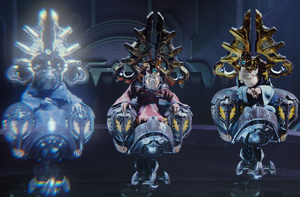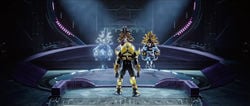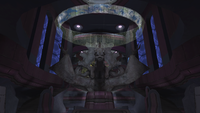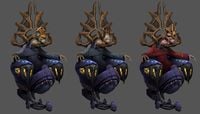Hierarchs: Difference between revisions
From Halopedia, the Halo wiki
Sith Venator (talk | contribs) |
(→Gallery: replace image) |
||
| Line 74: | Line 74: | ||
File:HW Arbiter talks to Regret.png|The Prophet of Regret speaking to [[Ripa 'Moramee]]. | File:HW Arbiter talks to Regret.png|The Prophet of Regret speaking to [[Ripa 'Moramee]]. | ||
File:TruthDeath-large.jpg|The death of the last Hierarch. | File:TruthDeath-large.jpg|The death of the last Hierarch. | ||
File: | File:H2 Gemini Statue.png|A monument to the Prophet of Truth. | ||
File:HierarchH2A.jpg|Art of the Hierarchs Regret, Mercy, and Truth. | File:HierarchH2A.jpg|Art of the Hierarchs Regret, Mercy, and Truth. | ||
</gallery> | </gallery> | ||
Revision as of 17:12, June 1, 2019
| Hierarchs | |
|---|---|

| |
| Political information | |
|
Type: |
Triumvirate |
|
Government: |
|
|
Member of: |
|
|
Duties: |
Leaders of the Covenant |
|
Term length: |
|
|
Headquarters: |
|
| Historical information | |
|
Formation: |
|
|
Abolished: |
|
|
Notable individuals: |
|
The Hierarchs, also known as High Prophets, served as the highest theocratic leaders of the Covenant High Council. Hierarchs rule with near absolute power over the Covenant, and the other races obey their will without question. The last three Hierarchs came to power in the beginning of the 9th Age of Reclamation in 2525.[1] The title of Hierarch was dissolved following the death of the High Prophet of Truth and the dissolution of the Covenant on December 11, 2552.[2]
Powers and duties
The title of Hierarch had existed before the establishment of the Covenant, as early as 860 BCE.[3] By the time of the Covenant's formation, the Hierarchs were a triumvirate composed of three San'Shyuum that served as the highest authorities among the Covenant and held the most political and religious power.[1] The true duty of the Hierarchs was to help guide the Covenant toward the Great Journey.[4] The Hierarchs led the Covenant High Council. Hierarchs had complete control over the distribution of all Forerunner relics and technology—likely more so than the Ministry of Fortitude—and could distribute them however the Hierarch thought best benefited the Covenant.[5] If an individual failed a "holy mission" assigned to them by a Hierarch, dire consequences would result and execution may occur.[6] Among their powers are composition and reorganization of fleets within the Covenant naval branch, even without the approval of the High Council,[7] and appointing an Arbiter from among the Sangheili to serve as the "Will of the Prophets".[8] The Hierarchs also had the authority to create new Ministries within the Covenant, sometimes for the personal gain and ambition of one Hierarch.[9] The Hierarchs often issued edicts ex cathedra; these edicts may have comprised general declarations, though they typically contained executive orders. As they were extensions of the Hierarchs' will, these edicts could not be refuted.[10]
The Hierarchs typically remained in the Covenant holy city of High Charity, although they would occasionally embark to lead a battle. The Hierarchs often occupied the High Council Chamber to led High Council sessions or hold court trials, along with the High Councilors of the Covenant. The Hierarchs could also assign duties and tasks to other members of the Covenant in the Hall of Sacred Guidance.[11] The Sanctum of the Hierarchs was the private quarters of the High Prophets that was only accessible to very high-ranking members of the Covenant.[12] The Palace of the Hierarchs was the private reception chamber used by the Hierarchs.[13]
The Hierarchs followed the Book of Hierarchs—an official ruling book.[14] Despite the Hierarchs' power and influence, they did not have right or power to stop the San'Shyuum that enforced the Roll of Celibates from completing their tasks.[15] A Hierarch assigning an important mission to individuals without informing the rest of the Hierarchs was considered a violation of Council protocol. However, the protocol was often violated. The High Prophet of Excellent Redolence tasked the Prophet of Inner Conviction with recovering a Luminary and female San'Shyuum on Janjur Qom without informing the rest of the Hierarchs.[16] The High Prophets of Truth and Regret often operated while keeping each other unaware of their separate, ambitious activities. Hierarchs could appoint other San'Shyuum to be their Secondary Administrator, essentially an assistant to the Hierarch.[17] Stewards would also serve as aids to Hierarchs.[18]
Each Hierarch was dressed in a loose-sleeved robe with different coloring. Hierarchs donned golden headdresses that displayed a blue holographic Halo installation on their forehead.[19] Hierarchs sat upon a gravity throne, luxurious anti-gravity chairs with gold, collar-like plating and were equipped with energy shielding.[20] The Hierarchs were always protected by the Covenant Honor Guard, with the Hierarch's personal guards always prepared to kill anything that attempted to harm the Hierarch. The Honor Guardsmen would also kill any individual that held an unholstered weapon in the presence of a Hierarch.[21] However, the Sangheili with the title of Arbiter seemingly were an exception to the law, as seen with Arbiter Ripa 'Moramee when he activated two Type-1 energy swords in front of a Hierarch.[22] The Hierarchs' gravity thrones were outfitted with a powerful gravity cannon that a Hierarch could to annihilate any possible threat.[19][23]
Appointment and succession
The inauguration of a new set of Hierarchs generally coincided with the beginning of a new Age. In order to become a Hierarch, a San'Shyuum would have to receive the "blessing" of the Oracle of High Charity. However, the Oracle had not spoken for millennia. Instead, the ascension process of a Hierarch was steeped in political machinations and often the bribery of the Oracle's keeper—the Philologist.[1][24] After speaking with the Oracle, the three San'Shyuum would announce their intentions to replace the current Hierarchs in front of the High Council and state their reasons. Although possible to announce their intent to the Council without a third San'Shyuum, it would make them seem less legitimate and a third individual would have to be selected after the announcement.[25] However, unseating a Hierarch was not an easy task, as the Hierarchs would often try to use all the influence they had at their disposal to keep their title and prevent the declaration of a new Age.[26] After being approved of by the High Council, a grand ceremony known as the Ascension would occur to formally declare the coming of a new Age and introduce the new Hierarchs to the rest of the Covenant. Then, the newly-risen Hierarchs would humbly ask the Oracle to bless the new Age. Upon their ascension, a Hierarch may choose a regal name from a list of former Hierarch names.[27]
During the appointment of a new Age and a new set of Hierarchs, it was acceptable for one of the previous Hierarchs to keep their title and position, and continuing serving as a Hierarch alongside two new ones. While this generally allowed for a smoother transition, bitterness would often ensure.[28] A Hierarch could step down from the throne if they believed that their health was becoming a concern.[9] However, a retired Hierarch could still voice their opinion in the High Council.[14] In the rare event of the death of a Hierarch, another high-ranking and influential San'Shyuum would be given the opportunity to replace the missing Hierarch.[29]
Known Hierarchs of the Reformists
- First Age of Conflict
Known Hierarchs of the Covenant
- First Age of Reconciliation
- High Prophet of Excellent Redolence (c. 850 BCE)
- High Prophet of the Glorious Journey (c. 850 BCE
- High Prophet of Unity (c. 850 BCE)
- Unknown Age
- 29th Age of Doubt
- High Prophetess of Obligation (?–2525)
- High Prophet of Tolerance (?–2525)
- High Prophet of Restraint (?–2525)
- 9th Age of Reclamation
- High Prophet of Regret (2525–November 2, 2552)
- High Prophet of Mercy (2525–November 3, 2552)
- High Prophet of Truth (2525–December 11, 2552; the last Hierarch of the Covenant)
Trivia

|
Browse more images in this article's gallery page. |
- Each of the three Hierarchs in the original Halo trilogy were killed by a different enemy of the Covenant faction. Regret was killed by UNSC, Mercy was killed by the Flood, and Truth was killed by Thel 'Vadam's Swords of Sanghelios. It is also worthy of note that all three were eventually infected by the Flood prior to or immediately following their deaths.
- The High Prophetess of Obligation is currently the only known female Hierarch.
- Many Prophets have titles that are the polar opposite of how they actually act. The easiest example of this could be the Prophet of Truth, who lied and schemed his way to the position of Hierarch. The Prophet of Regret is also an example, as he regrets nothing until his blunder in the Battle of Earth.
Gallery
The Prophet of Regret speaking to Ripa 'Moramee.
List of appearances
|
|
Sources
- ^ a b c d Halo Encyclopedia, page 125 (2011 edition)
- ^ a b Halo 3, campaign level The Covenant
- ^ Halo: Broken Circle, page 6
- ^ Halo Encyclopedia, page 126 (2011 edition)
- ^ Halo: Contact Harvest, page 159
- ^ Halo: The Cole Protocol, page 170
- ^ Halo: The Cole Protocol, page 349
- ^ Halo 2, campaign level The Arbiter
- ^ a b Halo: Broken Circle, page 51
- ^ Halo Wars, Timeline
- ^ Halo: Broken Circle, page 72
- ^ Halo: First Strike, pages 338-339
- ^ Halo: Broken Circle, page 194
- ^ a b Halo: Broken Circle, page 161
- ^ Halo: Contact Harvest, page 265
- ^ Halo: Broken Circle, page 73
- ^ Halo: Broken Circle, page 193
- ^ Halo 2: Anniversary, Terminal 1
- ^ a b Halo: Broken Circle, page 159
- ^ Halo Encyclopedia, page 136 (2011 edition)
- ^ Halo: The Cole Protocol, pages 144-145
- ^ Halo Wars, campaign level Scarab
- ^ Halo 2, campaign level Regret
- ^ Halo: Contact Harvest, page 274
- ^ Halo: Contact Harvest, pages 286-287
- ^ Halo: Contact Harvest, page 156
- ^ Halo: Contact Harvest, pages 379-383
- ^ Halo: Contact Harvest, page 268
- ^ Halo: Broken Circle, page 208










